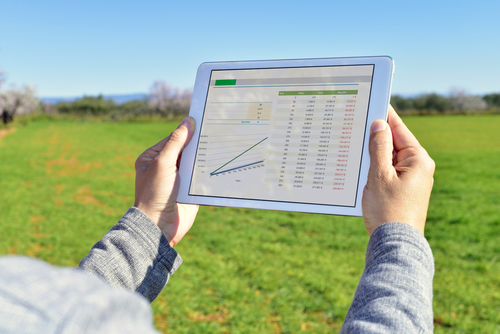Water-efficient Practices & Innovations
Putting Drones to Work
Drones are becoming part of our everyday lives, providing video and pictures for news articles, entertaining crowds at the Olympics, or buzzing around your local park. But for many farmers, drones are being put to work right now- improving how our farm products are being produced.
Rather than taking pictures and videos of people or events, they’re surveying fields, using their high-resolution sensors to measure crop health in order to improve crop yield and decrease agricultural water and chemical use.
Every crop is different! It goes without saying, but grapes are not tomatoes, and tomatoes are not corn. There are hundreds of different kinds of farms, ranging from perennial trees and vines to annual crops producing fruit and vegetables (and that’s not even including livestock and ranching).
Even every farm field is different! Different soils, drainage, and field contours mean that no two examples are alike. Farmers get to know their fields thoroughly, understanding where and how to customize their work to get the best results. They do this by monitoring and measuring their fields and crops.
Each field and specific crop needs to be measured differently to generate useful information that farmers can put to work improving their farms. There is no single method for monitoring crop health. Highly-specialized experts work to deliver these technology solutions to farmers and are a critical component of farming efficiently in California.
Weather Apps
Knowing when or when not to irrigate is important to have a successful harvest. In the past, farmers would often set an irrigation schedule and stick to it because of uncertain weather. Today, California’s farmers use specialized technology to help improve their farms and irrigate only when needed.
Having better local weather information at hand is a great way for farmers to improve their irrigation systems.
Adjusting irrigation systems to work in harmony with natural precipitation takes more work, but it’s a proven way to save water. There are numerous weather apps available that provide local and current precipitation reports.
Using these along with irrigation systems can help save water, which will save farmers money and reduce wear and tear on systems.
Tailored Irrigation
Farmers carefully match the type of irrigation system with the needs of their farm. Picking the right irrigation system is critical to be able to use water efficiently according to specific crop needs. Irrigation is more complex than just putting water in the fields, it’s a careful balance of plant health and vitality, groundwater recharge, and deliberate stewardship of a limited resource.
Drip irrigation systems deliver water directly to a plant’s roots, allowing for precise control of how much and where water is applied. Timers can be used to schedule watering for the cooler parts of the day, helping reduce water loss, while special equipment helps apply fertilizers and supplements through the drip tube. Properly installed drip irrigation has the potential to provide many water-efficiency benefits and can even contribute to increased crop yields.
Many types of conventional irrigation, often called gravity-fed as they don’t use electricity or fuel to pressurize the water, can also be used on farms in California. In addition to using less energy, gravity-fed irrigation can also help to recharge groundwater, an important reserve for dry years.
Water Recycling
If water reaches the end of a field, it is called runoff, and managing it is an important part of irrigation. Runoff can occur for many different reasons, and in any case is a natural result of irrigation to some degree.
Avoiding or managing runoff can save millions of gallons of water over the course of a growing season. One way farmers manage runoff is by recycling it as a supply for other fields or on other appropriate uses.
Recycling runoff not only helps save water, it helps save entire ecosystems. Agricultural runoff may contain unused fertilizer, or other components that have value and can be reused. By recycling water back through the field, farmers can help to ensure that water is used to its fullest extent and not wasted. The costs and effort of managing runoff are significant, but so are the benefits.






